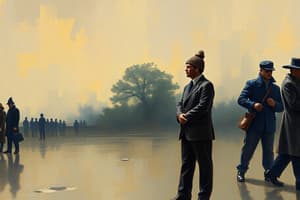Podcast
Questions and Answers
Which of the following scenarios BEST exemplifies the principle of equality of opportunity in sports?
Which of the following scenarios BEST exemplifies the principle of equality of opportunity in sports?
- A wealthy family donates a significant amount of money to a sports program, guaranteeing their child a spot on the team.
- A national sports organization mandates that all athletes, regardless of performance, receive equal media coverage.
- A government initiative provides funding for sports facilities and equipment in low-income communities, ensuring access for all children. (correct)
- A sports league implements a salary cap to ensure all teams have roughly the same amount of money to spend on players.
In the context of social stratification and sports, what is the MOST significant challenge to the idea of meritocracy?
In the context of social stratification and sports, what is the MOST significant challenge to the idea of meritocracy?
- The inherent variation in athletic talent among individuals.
- The natural decline in athletic performance as athletes age.
- The subjective nature of judging athletic performance.
- The unequal access to resources such as quality coaching and facilities based on socioeconomic status. (correct)
Which of these options BEST describes the difference between 'equality of opportunity' and 'equality of outcome'?
Which of these options BEST describes the difference between 'equality of opportunity' and 'equality of outcome'?
- Equality of opportunity is a concept supported by the political left, while equality of outcome is supported by the political right.
- Equality of opportunity focuses on eliminating all forms of discrimination, while equality of outcome aims to ensure everyone achieves the same level of success.
- Equality of opportunity focuses on individual effort, while equality of outcome focuses on societal structures.
- Equality of opportunity emphasizes equal access to resources and participation, while equality of outcome emphasizes equal distribution of goods and resources. (correct)
How might nepotism and networking present a barrier to meritocracy in sports?
How might nepotism and networking present a barrier to meritocracy in sports?
A sports program aims to promote equality of outcome by providing additional coaching and resources to athletes from underrepresented backgrounds. What potential challenge might arise from this approach?
A sports program aims to promote equality of outcome by providing additional coaching and resources to athletes from underrepresented backgrounds. What potential challenge might arise from this approach?
Imagine a scenario where a talented young athlete from a low-income family is unable to afford the training and equipment necessary to compete at an elite level. Which concept BEST describes the barrier this athlete is facing?
Imagine a scenario where a talented young athlete from a low-income family is unable to afford the training and equipment necessary to compete at an elite level. Which concept BEST describes the barrier this athlete is facing?
How do gender disparities challenge the notion of meritocracy in sports?
How do gender disparities challenge the notion of meritocracy in sports?
Which of the following statements BEST captures the central conflict in the debate about equality in sports, as described in the content?
Which of the following statements BEST captures the central conflict in the debate about equality in sports, as described in the content?
Flashcards
Gini Index
Gini Index
A measure of income inequality where 0 represents perfect equality and 1 represents total inequality.
Economic Capital
Economic Capital
Wealth and material resources available to an individual or household.
Cultural Capital
Cultural Capital
Education, tastes, and cultural knowledge that influence social standing.
Social Capital
Social Capital
Signup and view all the flashcards
Symbolic Capital
Symbolic Capital
Signup and view all the flashcards
Meritocracy
Meritocracy
Signup and view all the flashcards
Challenges to Meritocracy
Challenges to Meritocracy
Signup and view all the flashcards
Structural Inequalities in Sports
Structural Inequalities in Sports
Signup and view all the flashcards
Economic Factors in Sports
Economic Factors in Sports
Signup and view all the flashcards
Equality of Opportunity
Equality of Opportunity
Signup and view all the flashcards
Barriers to Equal Opportunity
Barriers to Equal Opportunity
Signup and view all the flashcards
Equality of Outcome
Equality of Outcome
Signup and view all the flashcards
Competing Ambitions in Equality
Competing Ambitions in Equality
Signup and view all the flashcards
Study Notes
- Addresses the intersection of class, opportunity, and sport in Canada.
Meritocracy in Sports
- It is defined as a system where performance dictates rank and rewards.
- It assumes sports are a level playing field.
- True meritocracy is challenged by existing barriers.
Challenges to Meritocracy
- Structural inequalities mean access to resources like coaching, equipment, and facilities depend on socioeconomic status.
- Economic factors show that participation in elite sports can be expensive due to training, travel, and competition fees.
- Discrimination bias results in gender disparities, where women receive less funding, media coverage, and fewer opportunities in sports.
- Nepotism and networking result in personal connections or family ties providing opportunities that are not equally accessible to all athletes.
Equality of Opportunity
- Equal access for all to participate.
- Barriers include class, gender, race, geography, and physical/cognitive ability.
- An example of barriers includes a lack of facilities and equipment for low-income families.
Equality of Outcome
- Requires individuals to have some share of goods and resources, not merely a chance to obtain them without the hindrance of some obstacles.
- An example is providing resources to marginalized groups through affirmative action.
Competing Ambitions
- The challenge is twofold.
- Eliminating inequalities based on foul play, structural barriers, elite collusion, and accidents of birth.
- Safeguarding the outcomes that reflect individual variation in effort and risk-taking.
Politicizing Inequality
- Those on the left believe equality is about equal outcomes.
- Those on the right are convinced that equal opportunities define equality.
- Social equality is noted as not straightforward.
- Attaining equality could be less important than the creation of an egalitarian society.
Historical Income Trends in Canada
- Income inequality has risen over the last 40 years.
- Economic recessions in the 1980s and 1990s contributed.
- Technology has eliminated middle-income jobs.
- Declining unionization and a reliance on temporary workers had an impact.
- Middle- and low-income groups are most affected during recessions.
Social Inequality in Canada (Gini Index)
- The Gini Index measures income inequality, where 0 equals perfect equality and 1 equals total inequality.
- The top 1% earns 11.2% of all income, contributing to a growing disparity since 1980.
- The Gini coefficient can measure inequality in medal distribution among countries in global events such as the Olympics.
- Wealthier nations often dominate due to superior training programs, facilities, and investment in athletes.
Pierre Bourdieu's Theory of Social Class
- Social class is not only determined by economic factors but also by cultural and social capital.
- Economic capital is wealth and material resources.
- Cultural capital includes education, tastes, and cultural knowledge.
- Social capital refers to social networks and connections.
- Symbolic capital is the prestige and recognition that comes from other forms of capital.
Programs to Support Low SES Families
- KidSport Canada is a national not-for-profit organization that provides financial assistance for registration fees and equipment to kids aged 18 and under, with grants varying by province.
- Canadian Tire Jump Start is a national charity that helps kids from financially disadvantaged families participate in organized sports and physical activities.
Studying That Suits You
Use AI to generate personalized quizzes and flashcards to suit your learning preferences.
Related Documents
Description
Explore the intersection of class, opportunity, and sport in Canada. It addresses meritocracy in sports and the challenges it faces. Structural inequalities, economic factors, discrimination bias, nepotism, and networking create barriers, that impact equal opportunity.




